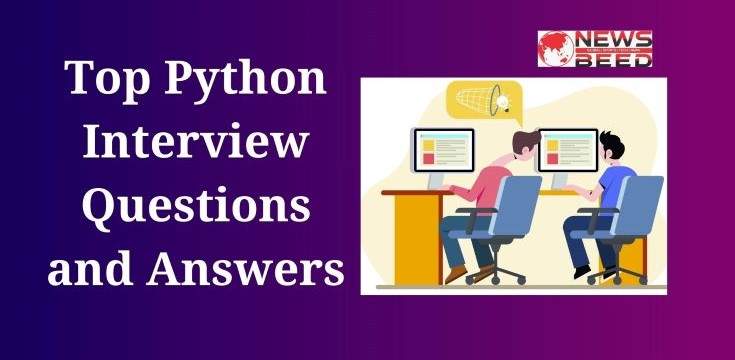Top Python Interview Questions and Answers: Python is a widely used programming language known for its simplicity, versatility, and readability. Aspiring Python developers often face interviews that assess their proficiency and understanding of the language. Common interview questions cover a range of topics, including fundamental concepts like data types, control structures, and functions, as well as more advanced topics like object-oriented programming, exception handling, and Python-specific libraries. Additionally, interviewers may inquire about web development frameworks, data science libraries, and best practices for writing clean and efficient code. Being well-prepared for Python interviews involves a solid understanding of both the basics and the more advanced aspects of the language, along with practical experience in applying Python to real-world scenarios.
Top Python Interview Questions and Answers
1. What is Python?
- Python is a high-level, interpreted programming language known for its readability and simplicity. It supports multiple programming paradigms, including procedural, object-oriented, and functional programming.
2. Explain the differences between Python 2 and Python 3.
- Python 3 is the latest version and is not backward compatible with Python 2. Key differences include changes in print statement, division behavior, and string handling.
3. What is PEP 8?
- PEP 8 is the Python Enhancement Proposal that provides guidelines for writing clean and readable code in Python.
4. What is a decorator in Python?
- A decorator is a design pattern in Python that allows you to extend or modify the behavior of functions or methods without changing their actual code.
5. Explain the Global Interpreter Lock (GIL).
- The Global Interpreter Lock is a mechanism in CPython (the reference implementation of Python) that prevents multiple native threads from executing Python bytecodes at once.
6. What are Python generators?
- Generators in Python are a way to create iterators. They allow you to iterate over a potentially large set of data without loading the entire dataset into memory.
7. How does exception handling work in Python?
- Python uses a try-except block for handling exceptions. Code within the try block is executed, and if an exception occurs, the except block is executed.
8. What is a virtual environment in Python?
- A virtual environment is a self-contained directory that contains its Python installation. It helps manage dependencies for different projects separately.
9. Explain the difference between a list and a tuple.
- Lists are mutable (can be modified), while tuples are immutable (cannot be modified). Tuples use parentheses, and lists use square brackets.
10. What is the difference between shallow copy and deep copy?
- A shallow copy creates a new object but does not create copies of nested objects. A deep copy creates a new object and recursively copies all objects found in the original.
11. How does Python’s garbage collection work?
- Python uses a garbage collector to automatically manage memory. It detects and frees up memory occupied by objects that are no longer in use.
12. What is the purpose of the __init__ method in Python classes?
- The
__init__method is a constructor in Python classes and is called when an object is created. It initializes the object’s attributes.
13. Explain the concept of duck typing.
- Duck typing is a programming concept where the type or class of an object is determined by its behavior rather than its explicit type or inheritance.
14. What is the difference between __str__ and __repr__?
__str__is called bystr()andprint()to display a human-readable string representation of an object.__repr__is used to generate the string representation of the object for inspection.
15. What is the purpose of the if __name__ == "__main__": statement?
- This statement checks whether the Python script is being run as the main program or if it is being imported as a module. It is often used to include/exclude code based on how the script is being used.
16. How do you handle file I/O in Python?
- Python provides built-in functions like
open(),read(),write(), andclose()for file I/O. Thewithstatement is often used to ensure proper handling of resources.
17. Explain the concept of decorators in Python.
- Decorators are a powerful and flexible feature in Python that allows the modification of the behavior of functions or methods. They are often used for tasks such as logging, timing, and authentication.
18. What is the difference between a module and a package in Python?
- A module is a single Python file, while a package is a collection of Python modules organized in a directory. Packages include a special file named
__init__.py.
19. What are lambda functions in Python?
- Lambda functions are anonymous functions created using the
lambdakeyword. They are often used for short, one-time operations.
20. How does inheritance work in Python?
- Inheritance allows a class to inherit attributes and methods from another class. The derived class can extend or override the functionality of the base class.
21. What is the Global Interpreter Lock (GIL)?
- The GIL is a mutex that protects access to Python objects, preventing multiple native threads from executing Python bytecodes at once.
22. Explain the use of *args and **kwargs.
*argsallows a function to accept a variable number of positional arguments, and**kwargsallows a function to accept a variable number of keyword arguments.
23. How are exceptions handled in Python?
- Exceptions are handled using
try,except,else, andfinallyblocks. Code in thetryblock is executed, and if an exception occurs, the correspondingexceptblock is executed.
24. What is a list comprehension?
- A list comprehension is a concise way to create lists in Python. It consists of an expression followed by at least one
forclause and zero or moreifclauses.
25. Explain the concept of the Python Global Interpreter Lock (GIL).
- The GIL is a mutex that protects access to Python objects, preventing multiple native threads from executing Python bytecodes at once.
26. How does memory management work in Python?
- Python uses a private heap to manage memory. The memory manager handles the allocation and deallocation of memory, and a garbage collector reclaims memory occupied by objects that are no longer in use.
27. What is the purpose of the __init__ method in Python classes?
- The
__init__method is a constructor in Python classes and is automatically called when an object is created. It is used to initialize the object’s attributes.
28. How can you handle exceptions in Python?
- Exceptions can be handled using
try,except,else, andfinallyblocks. Thetryblock contains the code that might raise an exception, and theexceptblock contains the code to handle the exception.
29. What is the purpose of the __str__ method in Python?
- The
__str__method is called by thestr()built-in function and theprint()function to get a string representation of an object. It should return a human-readable string.
30. How do you open and close a file in Python?
- The
open()function is used to open a file, and theclose()method is used to close it. It’s advisable to use thewithstatement for automatic resource management.
31. What is a Python iterator?
- An iterator is an object that can be iterated (looped) over. It implements the methods
__iter__()and__next__().
32. What is the purpose of the __name__ variable in Python?
- The
__name__variable is a special variable that represents the name of the current Python module. When a Python script is executed,__name__is set to'__main__'.
33. What is the difference between a shallow copy and a deep copy?
- A shallow copy creates a new object but does not create copies of nested objects. A deep copy creates a new object and recursively copies all objects found in the original.
34. How do you handle errors in Python?
- Errors can be handled using
try,except,else, andfinallyblocks. Thetryblock contains the code that might raise an exception, and theexceptblock contains the code to handle the exception.
35. Explain the use of the __slots__ attribute in Python.
- The
__slots__attribute is used to explicitly declare which attributes a class can have. It helps in reducing memory overhead and can improve performance.
36. What is the purpose of the if __name__ == "__main__": statement?
- This statement is used to check whether the Python script is being run as the main program or if it is being imported as a module.
37. How does the map() function work in Python?
- The
map()function applies a given function to all items in an input list (or other iterable) and returns an iterable map object (or a list if the result is converted).
38. What are decorators, and how do you use them in Python?
- Decorators are functions that modify the behavior of another function. They are applied using the
@decoratorsyntax. Common use cases include logging, timing, and memoization.
39. Explain the concept of monkey patching in Python.
- Monkey patching involves dynamically modifying or extending a class or module at runtime. It is typically done to change or enhance the behavior of existing code.
40. How does the super() function work in Python?
- The
super()function is used to call a method from the parent class. It is often used in the context of method overriding in inheritance.
41. What is the Global Interpreter Lock (GIL)?
- The GIL is a mutex that protects access to Python objects, preventing multiple native threads from executing Python bytecodes at once.
42. Explain the difference between shallow copy and deep copy.
- A shallow copy creates a new object but does not create copies of nested objects. A deep copy creates a new object and recursively copies all objects found in the original.
43. What are Python decorators?
- Decorators are a powerful and flexible feature in Python that allows the modification of the behavior of functions or methods without changing their code.
44. How does garbage collection work in Python?
- Python’s garbage collector automatically frees up memory by detecting and collecting objects that are no longer in use.
45. Explain the concept of the *args and **kwargs in Python.
*argsallows a function to accept a variable number of positional arguments, while**kwargsallows it to accept a variable number of keyword arguments.
46. What is the purpose of the __del__ method in Python?
- The
__del__method is used to define the actions that are executed when an object is about to be destroyed, typically during garbage collection.
47. How does Python support functional programming?
- Python supports functional programming with features like lambda functions, map(), filter(), and reduce(). It allows treating functions as first-class citizens.
48. What is the purpose of the with statement in Python?
- The
withstatement is used for resource management. It ensures that a context is properly acquired and released, even if an exception occurs within the block.
49. How can you handle errors and exceptions in Python?
- Errors and exceptions are handled using
try,except,else, andfinallyblocks. Thetryblock contains the code that might raise an exception, and theexceptblock contains the code to handle the exception.
50. What is the purpose of the pass statement in Python?
- The
passstatement is a no-operation statement. It is a placeholder when a statement is syntactically required but no action is desired or necessary.
You May Also Read:
What is Digital Marketing in Hindi
SEO Interview Questions and Answers
What is Affiliate Marketing Meaning
Google Search Console Interview Questions And Answers
Python Development Trends in 2024
Python has consistently ranked as one of the most popular and widely used programming languages, known for its simplicity, readability, and vast ecosystem of libraries and frameworks. Over the years, Python has found applications in various domains, from web development and data analysis to artificial intelligence (AI) and scientific computing. As we explore the development trends in Python, we’ll look at the areas of growth, emerging libraries and frameworks, and how Python is adapting to the evolving landscape of technology.
Growth in Data Science and Machine Learning
Python has become the lingua franca of data science and machine learning (ML). Libraries such as NumPy, Pandas, Matplotlib, SciPy, and Scikit-learn have made Python an excellent choice for data manipulation, statistical analysis, and data visualization. In recent years, the emergence of deep learning frameworks like TensorFlow, PyTorch, and Keras has further solidified Python’s position in the AI domain. These tools provide Python developers with powerful platforms for building and deploying complex neural networks and ML models, addressing a wide array of tasks from image and speech recognition to natural language processing (NLP).
Adoption in Web Development
In the realm of web development, Python continues to grow, primarily through the Django and Flask frameworks. Django, known for its “batteries-included” approach, offers developers a comprehensive solution with built-in features for frontend and backend development, whereas Flask provides a lightweight and flexible alternative, giving developers the freedom to choose their tools and libraries. The rise of asynchronous frameworks like FastAPI and Sanic is also noteworthy, catering to the increasing demand for high-performance, scalable web applications capable of handling large volumes of concurrent connections.
Evolution of Asynchronous Programming
Asynchronous programming has gained traction in the Python community, driven by the need for efficient I/O operations, especially in web development and data processing tasks. The introduction of the asyncio library and the async/await syntax in Python 3.5 marked a significant milestone, making it easier for developers to write asynchronous code. This has led to the development of asynchronous versions of libraries and frameworks, improving the performance and scalability of Python applications.
Focus on Typing and Performance
The introduction of type hints in Python 3.5 and the subsequent development of static type checkers like mypy have addressed one of the long-standing criticisms of Python: the lack of static typing. Type annotations help improve code readability, make debugging easier, and enable better support from development environments through more accurate code completion and error detection. On the performance front, projects like PyPy (an alternative Python interpreter) and Cython (a compiler for writing C extensions for Python) continue to offer paths for optimizing Python code, addressing Python’s performance limitations compared to compiled languages.
Development in Scientific Computing and Visualization
Python’s role in scientific computing and data visualization continues to expand with libraries such as NumPy for numerical computing, SciPy for scientific computing, and Matplotlib for plotting and visualization. Newer libraries and tools like Plotly and Dash for interactive web visualizations, and Jupyter Notebooks for interactive computing and data analysis workflows, have become indispensable tools for scientists, researchers, and data analysts.
Job Opportunities in Python
Python, one of the most popular programming languages today, offers a plethora of job opportunities across various domains. Its simplicity, versatility, and robust community support have made it a favorite among both beginners and seasoned professionals. Python’s applications range from web and software development to data analysis, machine learning, artificial intelligence, scientific computing, and more. This broad spectrum of applications translates into a diverse range of job roles for Python enthusiasts.
Web and Software Development
Python’s frameworks such as Django and Flask have simplified web development, allowing developers to build secure, scalable, and maintainable web applications efficiently. Python developers can work as backend developers, full-stack developers, or web developers, focusing on server-side logic, database management, and integration of user-facing elements developed by front-end developers. Python’s simplicity and readability make it an excellent choice for software development, including desktop applications, command-line scripts, and even games, with Pygame being a popular module for game development.
Data Analysis and Data Science
With the explosion of big data, Python has become the go-to language for data analysts and data scientists. Libraries such as Pandas, NumPy, and Matplotlib facilitate data manipulation, analysis, and visualization, enabling professionals to derive insights from large datasets. Data analysts typically focus on processing and analyzing data to answer specific questions, while data scientists may build predictive models and use machine learning algorithms to extract deeper insights and forecast trends. Python’s role in data science is indispensable, given its efficiency in handling and processing data.
Machine Learning and Artificial Intelligence
Python’s contribution to the fields of machine learning (ML) and artificial intelligence (AI) is significant. Libraries like TensorFlow, PyTorch, and Scikit-learn provide powerful tools for building and training machine learning models, including neural networks for deep learning applications. Professionals working in this domain typically focus on developing algorithms that enable computers to learn from and make decisions based on data. The demand for ML engineers and AI researchers is skyrocketing as industries seek to leverage these technologies for competitive advantage.
Scientific Computing and Academic Research
Python’s application extends to scientific computing, where it is used for simulations, modeling, and analysis in various scientific disciplines. Libraries such as SciPy and BioPython cater to specific fields like physics, engineering, and biology, respectively. Academics and researchers utilize Python not only for its computational capabilities but also for its ability to automate mundane data processing tasks, making it an invaluable tool in pushing the boundaries of scientific knowledge.
Cybersecurity
With cybersecurity becoming a critical concern for organizations worldwide, Python has emerged as a key player in developing security software and tools. Its ability to script automated tasks and analyze security data makes it a preferred choice for cybersecurity professionals. Python is used for developing intrusion detection systems, network scanners, and vulnerability assessment tools, among others.
DevOps and System Administration
Python simplifies many tasks associated with DevOps and system administration, such as automation of server setup, deployment, and network configuration. Libraries like Fabric and Ansible are used for scripting deployment and operational tasks, making Python a valuable skill for DevOps engineers and system administrators.
Python Developer Salary in India
The landscape of Python developer salaries in India is dynamic and influenced by a myriad of factors including geographical location, experience, skillset, and the type of industry. Python, being one of the most popular programming languages globally due to its simplicity and versatility, has seen a significant surge in demand across various sectors such as web development, data science, machine learning, artificial intelligence, automation, and cybersecurity. This demand directly impacts the salary trends for Python developers in India.
Entry-Level Python Developer Salary
For entry-level Python developers, those with less than one year of experience, the salary range can vary significantly. Starting salaries are competitive, as the demand for skilled programmers outpaces supply. An entry-level Python developer in India can expect to earn somewhere between INR 3,00,000 to INR 5,00,000 per annum. This range can be influenced by the individual’s proficiency in Python, understanding of related technologies and frameworks (like Django or Flask for web development), and any internships or project experience.
Mid-Level Python Developer Salary
As Python developers gain experience and expand their skillset, their value in the job market increases. Developers with 1-4 years of experience can be considered mid-level and can expect a significant jump in their compensation. Salaries in this bracket typically range from INR 5,00,000 to INR 10,00,000 per annum. Factors that can further boost salary include specialization in high-demand areas like data analysis, machine learning, or development of complex back-end systems, as well as proficiency in complementary technologies.
Senior-Level Python Developer Salary
Senior Python developers, with 5-9 years of experience, possess a deep understanding of Python, with expertise in various frameworks and technologies. They are often responsible for leading projects, mentoring junior developers, and making critical decisions regarding project architecture and technology stack. In India, a senior Python developer can earn between INR 10,00,000 to INR 20,00,000 per annum, depending on their exact experience, skills, and the company they work for. Those with expertise in areas like machine learning, AI, and data science can command the higher end of this range.
Factors Influencing Python Developer Salaries in India
- Geographical Location: Metropolitan cities like Bangalore, Hyderabad, Pune, and Mumbai generally offer higher salaries compared to other cities. This is due to the concentration of tech companies and startups in these areas.
- Skillset and Expertise: Developers with a broad skillset that includes knowledge of Python frameworks (Django, Flask), front-end technologies (JavaScript, HTML, CSS), and specialization in fields like AI, ML, or data science, tend to earn more.
- Type of Industry: Python developers working in industries like software development, fintech, and e-commerce might earn more due to the high demand for Python in these sectors.
- Company Size and Type: Larger and well-established companies often offer higher salaries compared to startups. However, startups might offer equity or stock options which can be lucrative in the long run.
Conclusion:
In conclusion, preparing for a Python interview requires a solid understanding of fundamental concepts such as data structures, algorithms, and object-oriented programming. Proficiency in Python-specific features like list comprehensions, decorators, and generators is essential. Demonstrating knowledge of popular libraries and frameworks, such as NumPy, Pandas, and Django, can also enhance your candidacy. Additionally, showcasing problem-solving skills through coding exercises and discussing real-world applications of Python can set you apart. Stay updated on the latest developments in the Python ecosystem and be ready to discuss your past experiences and projects in detail. Ultimately, a well-rounded skill set and a clear ability to apply Python in various scenarios will position you strongly in a Python interview.




